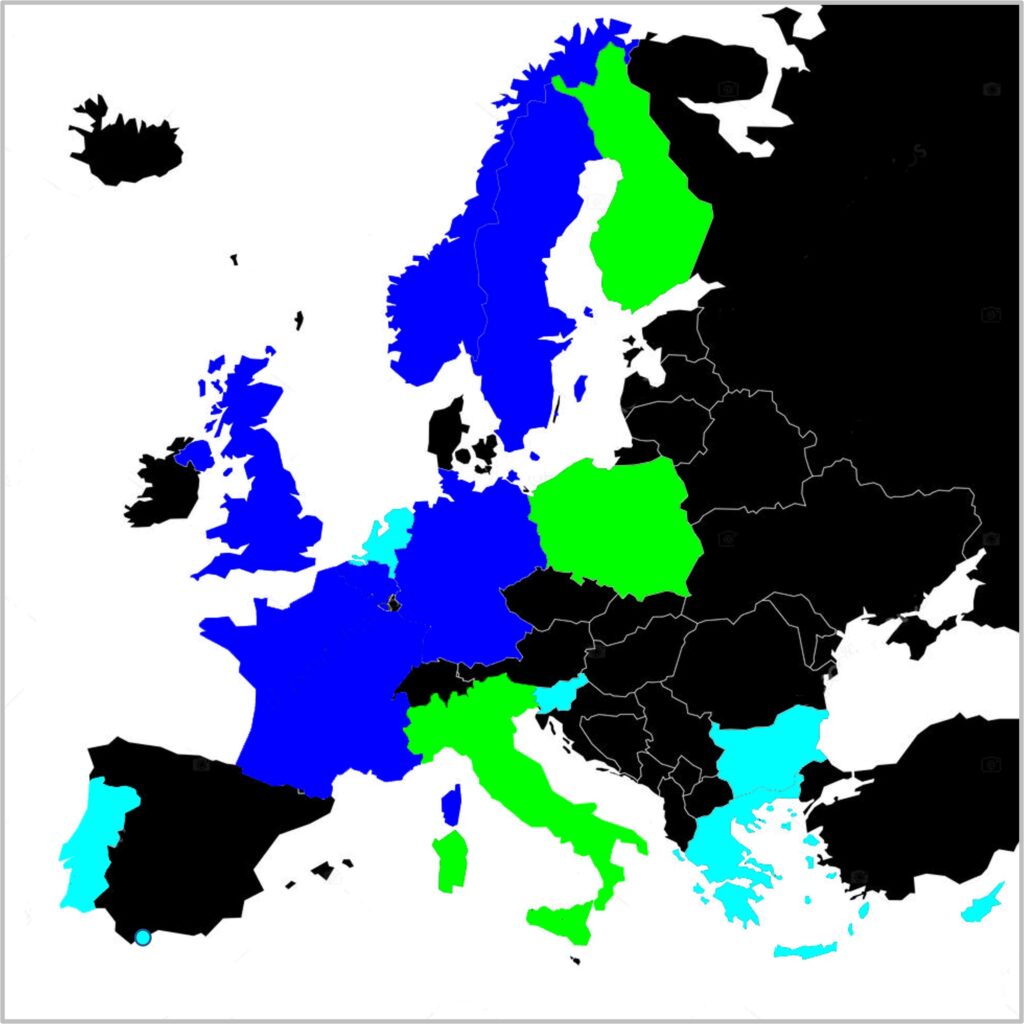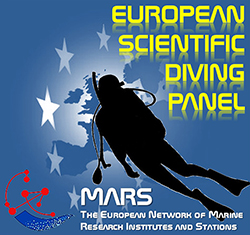The overall aim of the ESDP is to encourage the best possible representation from all European member states (to include all nations that are approved for EU scientific funding). Membership is at the nation level but with an identified representative. At the earliest opportunity the national representative should be able to demonstrate recognition and support from a national scientific diving community or committee. Where possible, any national body or community should have, or be seeking, formal backing from a national authority that is one that has principal responsibility for occupational scientific diving ; it may be a governmental, funding or insurance agency that may qualify the divers and/or support their employment.
ESDP membership :
Candidate member (light blue): Creating a NSDC; on the way to implement ESD and AESD as minimum initial training standards [Requirement: Updated list of members and involved institutions, quality control of the initial training and of competence certificate issuing]
Member (green): Having in place a NSDC in contact with a national authority that has responsibility for occupational SD (OSD) and having already implemented the ESD and AESD qualifications as the primary standards on a documented pathway including the description of the quality control process [Supplementary requirement: Published statutes, minutes of meetings and/or newsletter, name of the national certification, authority issuing certification, annually updated statistics of the national OSD activity (number of divers, dives, including incidents or accidents, given §2.3 of the ToR – recommended)]
Statutory member (blue): OSD and NSDC recognized by law, as well as ESD and AESD competencies levels [Supplementary requirement: Legal texts, official list of the agreed formation centres, annually updated statistics of the OSD national activity (number of divers, dives, including incidents or accidents, given §2.3 of the ToR – compulsory)]
Current national representatives at the ESDP [Member countries’ statutes are being updated after the decision from May 2023 ESDP meeting, representatives updated May 2025]
- BE– Dr. Alain Norro, Royal Belgium Institute of Natural Sciences, Bruxelles, Belgium working group on Scientific Diving (BWGSD).
- BG– Dr. Dimitar Berov, BG, Institute of Biodiversity and ecosystem research, Bulgarian Academy of Sciences
- CY– Dr. Louis Hadjiaoannou, CMMI, Cyprus Marine and Maritime Institute, Larnaca
- DE– Prof. Dr. Philipp Fischer, AWI, Helgoland, Kommission Forschungstauchen Deutschland (KFT).
- FI– Rupert Simon., Tervalampi, Suomen tutkimussukelluksen ohjauskomitea (FSDSA).
- FR– Dr. Jean-Pierre Féral, CNRS, Station Marine d’Endoume, Marseille, Comité National de la Plongée Scientifique (CNPS) [chairman 2008-2012 and 2016-to date]
- GI– Clive Crisp, Environment Officer, Department of the Environment, Sustainability, Climate Change and Heritage, HM Government of Gibraltar
- GR– Dr Thanos Dailianis, Hellenic Centre for Marine Research, Heraklion
- IT– Dr Massimo Ponti, Università di Bologna, Italian Association of Scientific Divers (AIOSS)
- NL– Pr Dr AJ (Tinka) Murk, Wageningen University, the Dutch Scientific Diving Platform
- NO– Dr. Pernilla Marianne Carlsson, Norwegian Institute for Water Research, Tromsø, Norwegian Scientific Divers (NSD).
- PL– Dr. Piotr Balazy, Institute of Oceanology, Polish Academy of Sciences · Marine Ecology Department
- PT– Diogo Paulo, Centre of Marine Sciences – University of Algarve, Faro e Região, Portugal, Associação Portuguesa de Mergulho Científico (APorMC).
- SL– Dr. Borut Mavrič, National Institute of Biology, Marine Biology Station Piran
- SE– Dr. Jesper Ström, Stockholm University, Swedish Scientific Diving Committee (SSDC).
- UK– Dr. Jon Chamberlain, University of Essex (CSEE), Scientific Diving Supervisory Committee (SDSC)

